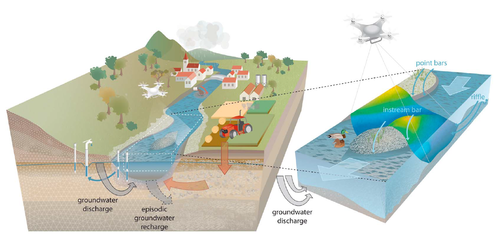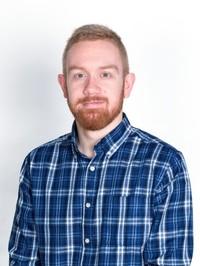Pardo Álvarez, Álvaro
MSCA Early-stage Researcher (PhD Student)
Research
PhD Project: Closing the conceptual gap between the hyporheic zone and the river corridor
Despite their critical importance for stream ecology, biogeochemistry and water quality, the interactions and feedback mechanisms across the different spatial and temporal scales of the hyporheic zone and the river corridor remain poorly understood. Although numerous modelling studies on hyporheic exchange have advanced our understanding of general mechanisms, they are often focused on local-scale processes with highly simplified boundary conditions. This may lead to a misrepresentation of the hyporheic exchanges and biogeochemical turnover capacity in river corridors. To close this conceptual gap, we aim to provide and integrate field and modelling approaches to quantify exchange fluxes and processes between the hyporheic and stream system across different spatial and temporal scales (see Figure 1) for a highly instrumented field site in Switzerland (Emme-catchment). In order to achieve this objective, the surface flow model OpenFOAM will be initially used to obtain local hydraulic heads at the riverbed. Results of streambed pressure will be then used to drive a subsurface flow and reactive transport model (local coupling) to simulate both exchange flow and biogeochemical turnover in the hyporheic sediments. Transient reach-scale boundary conditions for the latter hyporheic model will be directly obtained from the integrated surface-subsurface hydrological model HydroGeoSphere. These models will be based on a high-resolution characterization of the streambed acquired with a state-of-the-art LIDAR-UAV and will integrate new and innovative tracer-based methods taking advantage of very recent developments in sensor technology, such as the portable mass spectrometer (MiniRuedi) developed by Brennwald et al. [2016] for on-site dissolved gas concetrations analysis, in addition to hydraulic – and also UAV- field data. Using this approach, we expect that simulation results will provide a more realistic representation of hyporheic flows and the dynamics feedbacks between the stream channel, hyporheic zone and the underlying aquifer than by using steady hydraulic boundaries.
This project has received funding from the European Union's Horizon 2020 research and innovation programme under the Marie Sklodowska-Curie Grant Agreement Nº 722028 (ENIGMA ITN).

Figure 1. Nested spatial scales of river water and groundwater interactions: reach scale (left) and hyporheic scale (right) [Brunner, P. (2017)]
Positions held:
- 2017 - Present: MSCA Early-stage Researcher in Hydrogeology (ENIGMA ITN), Centre for Hydrogeology and Geothermics, University of Neuchâtel (UniNE), Switzerland
- 2016 - 2017: Water Resources Engineer (Hydrological and Hydraulic Modelling), Department of Environmental and Patrimonial Impacts, Empresa de Desenvolvimento e Infra-estruturas do Alqueva, S.A. (EDIA), Portugal
- 2016: Junior Hydrological Consultant, Department of Modelling Solutions, Amphos 21 Consulting S.L., Spain
- 2014 - 2015: Research Assistant in Hydrological Modelling (Intern Student), Centre Eau Terre Environnement, Institut National de Recherche Scientifique (INRS), Canada
Education:
- 2017 - Present: PhD in Hydrogeology, Centre for Hydrogeology and Geothermics, University of Neuchâtel (UniNE), Switzerland
- 2013 - 2016: BEng in Civil Engineering (adaptation to Bologna Process), Higher Polytechnic School of Engineering, University of Santiago de Compostela (USC), Spain
- 2012 - 2015: MSc in Water Engineering,
Higher Technical School of Civil Engineering, University of A Coruña (UDC), Spain
Department of water and waste management, Magdeburg-Stendal University of Applied Sciences (FH), Germany
Centre Eau Terre Environnement, Institut National de Recherche Scientifique (INRS), Canada
- Master Thesis: Inter-comparison study of PIHM and HYDROTEL – Beyond comparing streamflows (10.13140/RG.2.2.32893.05600/1).
- 2009 - 2012: BEng in Civil Engineering, Higher Polytechnic School of Engineering, University of Santiago de Compostela (USC), Spain
Honours and Awards:
- 2017: Marie Skłodowska-Curie Actions (MSCA) Fellowship for Early-stage Researchers (ESR), ENIGMA ITN - European Commission
- 2017: End-of-Degree Extraordinary Prize, Governing Council of the University of Santiago de Compostela (USC)
- 2015: Third End-of-Degree National Prize of University Education, Spanish Ministery of Education, Culture and Sport






